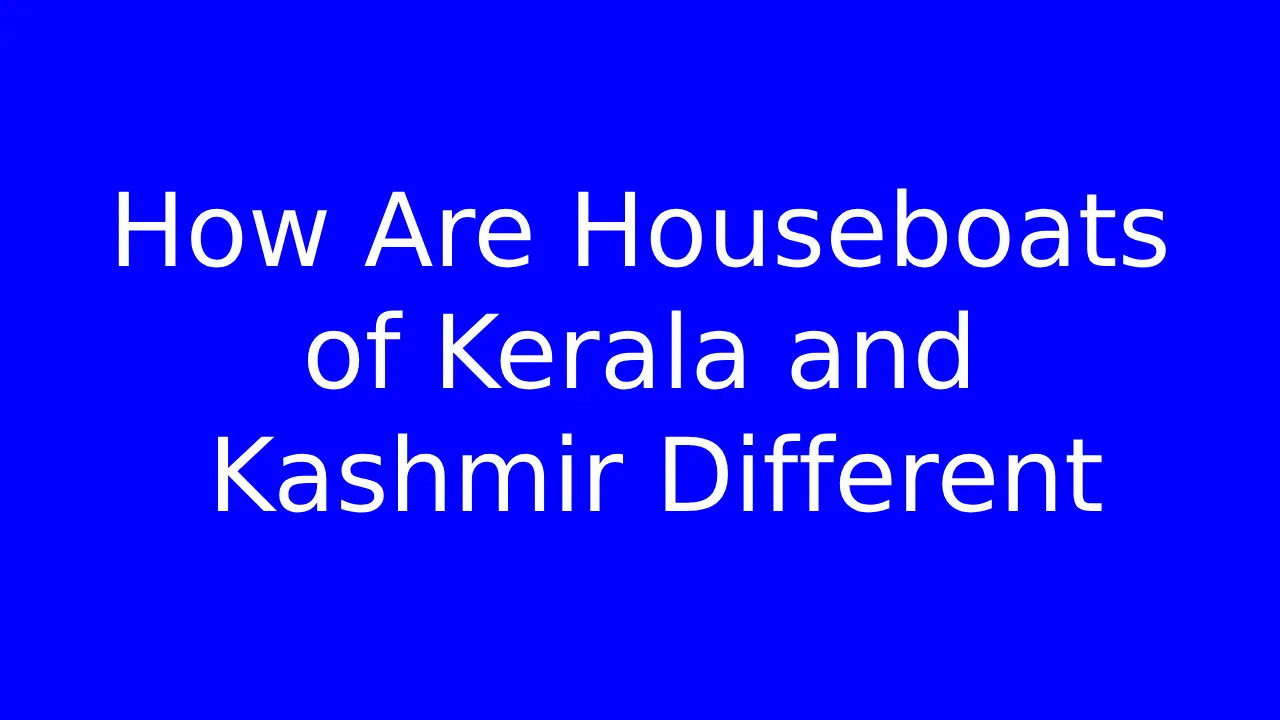How Are Houseboats of Kerala and Kashmir Different: Houseboats are iconic symbols of leisurely travel and exploration, offering a unique way to experience the serene beauty of water bodies. While Kerala and Kashmir are both renowned for their picturesque landscapes and vibrant cultures, the houseboats in these regions exhibit distinct characteristics that set them apart. In this article, we’ll delve into the differences between the houseboats of Kerala and Kashmir, exploring their history, design, tourism offerings, and more.
History and Tradition | How Are Houseboats of Kerala and Kashmir Different
In Kerala, houseboats, locally known as “kettuvallams,” have a rich history dating back centuries. Originally used for transporting goods across the backwaters, these traditional vessels have been transformed into luxurious floating accommodations for tourists. In contrast, houseboats in Kashmir, called “shikaras,” have a more utilitarian origin, serving as means of transportation and fishing in the picturesque Dal Lake and other water bodies.
Design and Architecture
Kerala houseboats typically feature a distinctive design with sloping roofs made of thatched palm leaves or bamboo mats. They are often adorned with intricate wood carvings and furnished with modern amenities to provide a comfortable stay for guests. On the other hand, Kashmiri houseboats are renowned for their elegant wooden architecture, characterized by intricately carved facades and spacious interiors adorned with traditional Kashmiri motifs.
Location and Scenery
The landscapes surrounding Kerala houseboats are dominated by the tranquil backwaters, lush greenery, and coconut groves, offering a serene and idyllic setting for travelers. In contrast, Kashmiri houseboats float amidst the majestic Himalayan mountains, with the shimmering waters of Dal Lake reflecting the snow-capped peaks and vibrant gardens of floating lotuses.
Lifestyle and Tourism
The experiences offered on Kerala houseboats focus on leisurely cruises through the backwaters, allowing guests to relax and soak in the natural beauty while enjoying traditional Kerala cuisine and hospitality. In Kashmir, houseboat stays are often combined with shikara rides, offering a glimpse into the vibrant local culture and handicrafts as guests traverse the bustling floating markets and gardens.
Cuisine and Hospitality | How Are Houseboats of Kerala and Kashmir Different
Kerala houseboats are renowned for their delectable seafood dishes prepared using fresh local ingredients, along with traditional Kerala meals served on banana leaves. In contrast, Kashmiri houseboats offer a culinary journey through the rich flavors of Kashmiri cuisine, including fragrant rice dishes, succulent kebabs, and saffron-infused desserts, served with warm hospitality and personalized service.
Business Ideas for Women at Home 2024: Turning Passion into Profit
Accessibility and Infrastructure | How Are Houseboats of Kerala and Kashmir Different
Kerala’s extensive network of backwaters ensures easy accessibility to houseboat cruises, with various boarding points located across the region. In Kashmir, houseboats are primarily concentrated around Dal Lake, offering convenient access to nearby attractions such as the Mughal gardens and historic landmarks.
Environmental Impact | How Are Houseboats of Kerala and Kashmir Different
Both Kerala and Kashmir have implemented measures to promote eco-friendly tourism practices and preserve the pristine beauty of their water bodies. Kerala has introduced regulations to minimize pollution and ensure sustainable waste management in the backwaters, while Kashmir is actively involved in conservation efforts to protect the fragile ecosystem of Dal Lake and its surrounding wetlands.
Economic Significance | How Are Houseboats of Kerala and Kashmir Different
Houseboat tourism plays a significant role in the economies of both Kerala and Kashmir, providing livelihoods for local communities through employment opportunities in hospitality, tourism, and artisanal crafts. The revenue generated from tourism also contributes to the development of infrastructure and conservation initiatives in these regions.
Cultural Exchange and Influence | How Are Houseboats of Kerala and Kashmir Different
Houseboat tourism fosters cultural exchange and interaction between tourists and local communities, providing opportunities for visitors to learn about the traditions, customs, and way of life in Kerala and Kashmir. Through interactions with local artisans and performers, travelers gain insight into the rich cultural heritage and artistic traditions of these regions.
Challenges and Future Prospects | How Are Houseboats of Kerala and Kashmir Different
Despite their popularity, houseboat tourism in Kerala and Kashmir faces challenges such as environmental degradation, overcrowding, and regulatory issues. However, there is immense potential for sustainable growth and development through the implementation of responsible tourism practices and community-based initiatives.
Comparison in Popularity | How Are Houseboats of Kerala and Kashmir Different
While both Kerala and Kashmir offer enchanting houseboat experiences, their popularity among tourists may vary depending on factors such as accessibility, infrastructure, and seasonal attractions. Kerala’s backwaters attract a steady stream of visitors throughout the year, while Kashmir’s houseboats experience peak tourist seasons during the summer and autumn months.
Recommendations for Travelers | How Are Houseboats of Kerala and Kashmir Different
Travelers seeking a tranquil retreat amidst lush greenery and serene backwaters may prefer Kerala houseboats, while those craving adventure and mountain vistas may opt for the enchanting beauty of Kashmiri houseboats. Regardless of the destination, it’s essential to research and plan ahead to ensure a memorable and fulfilling houseboat experience.
Sabse Jyada Paise Dene Wala Business 2024 [100% Best Idea]
Testimonials and Reviews | How Are Houseboats of Kerala and Kashmir Different
“I had the most relaxing time cruising through the backwaters of Kerala on a traditional houseboat. The serene surroundings and warm hospitality made it a truly unforgettable experience!” – Sarah, UK
“My stay on a Kashmiri houseboat was nothing short of magical. From the stunning views of Dal Lake to the delicious Kashmiri cuisine, every moment felt like a dream come true.” – Rajesh, India
Conclusion
In conclusion, while both Kerala and Kashmir offer enchanting houseboat experiences, each destination has its own unique charm and appeal. Whether you prefer the tranquil backwaters of Kerala or the majestic beauty of Kashmir’s lakes and mountains, a houseboat journey promises an unforgettable adventure filled with cultural discoveries and scenic wonders.
FAQs – How Are Houseboats of Kerala and Kashmir Different
Are houseboats in Kerala and Kashmir affordable for budget travelers?
Houseboat rates vary depending on the season and the level of luxury, but both destinations offer options to suit different budgets, including budget-friendly accommodations.
Can I book a houseboat cruise online in advance?
Yes, many tour operators and travel agencies offer online booking options for houseboat cruises in Kerala and Kashmir, allowing travelers to secure their reservations in advance.
Are houseboats in Kashmir accessible to travelers with mobility issues?
While some houseboats in Kashmir may have limited accessibility features, it’s advisable to check with the respective operators to ensure a comfortable stay for travelers with mobility challenges.
What activities can I enjoy during a houseboat stay in Kerala?
Popular activities include birdwatching, village walks, canoeing, and Ayurvedic massages, providing a diverse range of experiences for guests to enjoy amidst the tranquil backwaters.
Is it safe to travel to Kerala and Kashmir for a houseboat vacation?
Both Kerala and Kashmir are popular tourist destinations with well-established tourism infrastructure and safety measures in place, ensuring a secure and enjoyable experience for travelers.








